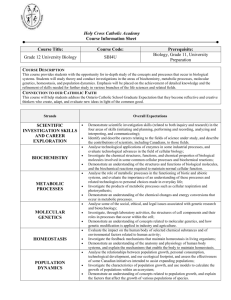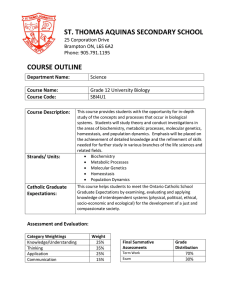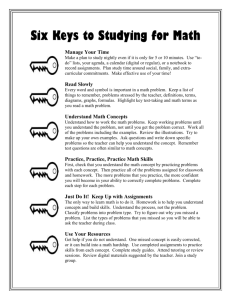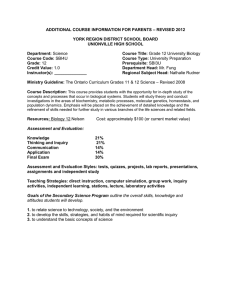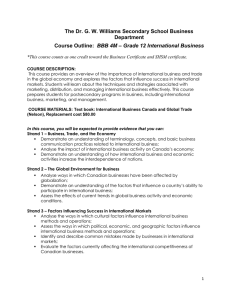e SCIENCE DEPARTMENT John Cabot Catholic Secondary School
advertisement
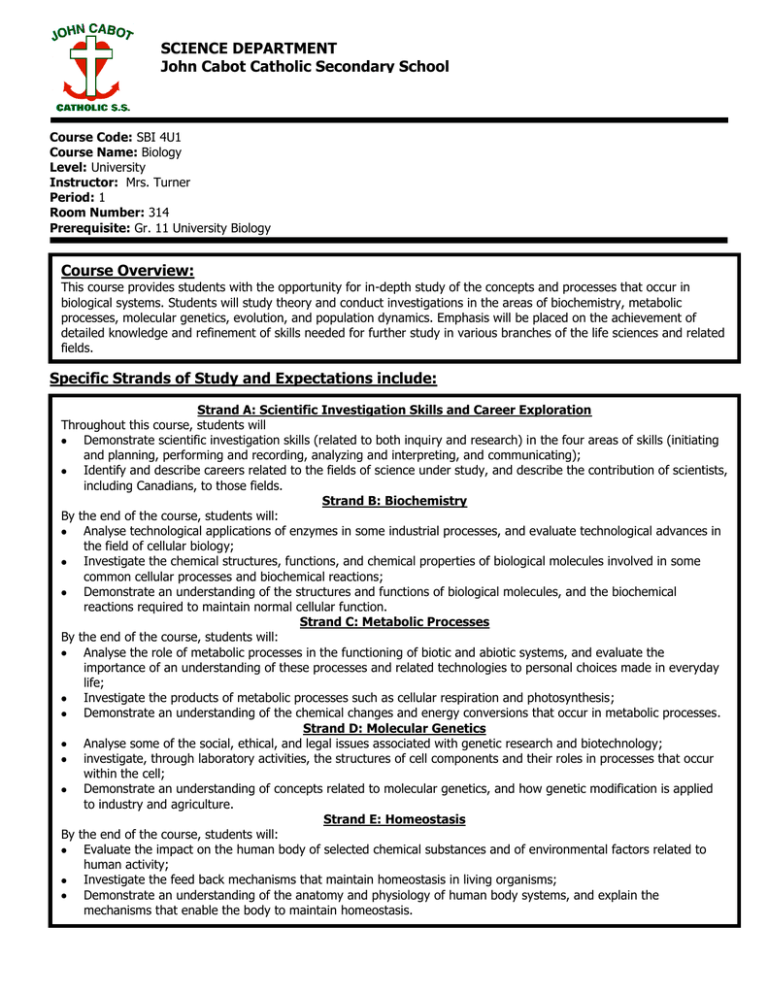
e SCIENCE DEPARTMENT John Cabot Catholic Secondary School Course Code: SBI 4U1 Course Name: Biology Level: University Instructor: Mrs. Turner Period: 1 Room Number: 314 Prerequisite: Gr. 11 University Biology Course Overview: This course provides students with the opportunity for in-depth study of the concepts and processes that occur in biological systems. Students will study theory and conduct investigations in the areas of biochemistry, metabolic processes, molecular genetics, evolution, and population dynamics. Emphasis will be placed on the achievement of detailed knowledge and refinement of skills needed for further study in various branches of the life sciences and related fields. Specific Strands of Study and Expectations include: Strand A: Scientific Investigation Skills and Career Exploration Throughout this course, students will Demonstrate scientific investigation skills (related to both inquiry and research) in the four areas of skills (initiating and planning, performing and recording, analyzing and interpreting, and communicating); Identify and describe careers related to the fields of science under study, and describe the contribution of scientists, including Canadians, to those fields. Strand B: Biochemistry By the end of the course, students will: Analyse technological applications of enzymes in some industrial processes, and evaluate technological advances in the field of cellular biology; Investigate the chemical structures, functions, and chemical properties of biological molecules involved in some common cellular processes and biochemical reactions; Demonstrate an understanding of the structures and functions of biological molecules, and the biochemical reactions required to maintain normal cellular function. Strand C: Metabolic Processes By the end of the course, students will: Analyse the role of metabolic processes in the functioning of biotic and abiotic systems, and evaluate the importance of an understanding of these processes and related technologies to personal choices made in everyday life; Investigate the products of metabolic processes such as cellular respiration and photosynthesis; Demonstrate an understanding of the chemical changes and energy conversions that occur in metabolic processes. Strand D: Molecular Genetics Analyse some of the social, ethical, and legal issues associated with genetic research and biotechnology; investigate, through laboratory activities, the structures of cell components and their roles in processes that occur within the cell; Demonstrate an understanding of concepts related to molecular genetics, and how genetic modification is applied to industry and agriculture. Strand E: Homeostasis By the end of the course, students will: Evaluate the impact on the human body of selected chemical substances and of environmental factors related to human activity; Investigate the feed back mechanisms that maintain homeostasis in living organisms; Demonstrate an understanding of the anatomy and physiology of human body systems, and explain the mechanisms that enable the body to maintain homeostasis. Strand F: Population Dynamics Analyse the relationships between population growth, personal consumption, technological development, and our ecological footprint, and assess the effectiveness of some Canadian initiatives intended to assist expanding populations investigate the characteristics of population growth, and use models to calculate the growth of populations within an ecosystem; Demonstrate an understanding of concepts related to population growth, and explain the factors that affect the growth of various populations of species. Course Breakdown (approximate timelines) Unit 1: Biochemistry 15 days Biological molecules and their chemical properties Cellular processes and chemical reactions Unit 2: Metabolic Processes 15 days Cellular Respiration and Photosynthesis Conversion of Energy in Biological Systems Unit 3: Molecular Genetics DNA and Protein Synthesis Genetic Research and Biotechnology 15 days Unit 4: Homeostasis 15 days Endocrine, Excretory and Nervous Systems Impact of Environmental Factors Unit 5: Population Dynamics Patterns of Population Growth and Decline Impact of Populations on Sustainability 15 days Resources: The course will use a variety of resources including video, CD-ROM, Internet Applications and a variety of print sources. The textbook Biology 12 will be distributed to students during the first week of the course. The text and all other resources assigned to students are the responsibility of the student. Any damage incurred will result in payment for replacement. Replacement cost for the text is $80.00. Evaluation Structure:: Knowledge and Understanding Thinking and Investigation Communication Application 25% 35% 15% 25% The above is reflected both in the term work (worth 70%) and the final exam (worth 30%). Efforts will be made to meet the individual learning needs of students in order to ensure these expectations are being met. Evaluation Policy Students will be assessed and evaluated according to the work produced and the skills displayed. Methods of providing feedback will include assessing work in process and evaluating completed assignments, tests, co-operative learning activities, simulations and presentations. Peer and self-evaluations will also be utilized. Student marks will be determined by evaluating process and product according to 4 categories and 4 levels. Please see the chart below for specific skills and key words used to determine student competency in the different categories. Level Level 1: Level 2: Level 3: Level 4: Category 50-59% 60-69% 70-79% 80-100% Knowledge and Understanding -Limited -Some -Considerable -Thorough Knowledge of facts and terms display of success in display of understanding Understanding of concepts and relationships knowledge, displaying knowledge of concepts and skills and knowledge, skills and ability ability to Thinking and Investigation ability to skills and to apply communicate, Critical and creative thinking skills apply application of concepts think creatively Inquiry, research and problem solving skills concepts concepts and apply Communication concepts Communication of ideas and information Use of symbols, visuals and diagrams Application Applications in familiar contexts Transfer of concepts to new contexts Making logical conclusions and predictions Feedback will also be provided for student learning skills. Skills like working independently, team work, organization, work habits and homework, and initiative are assessed independently student achievement and will be conducted through the use of a rubric indicating specific criteria to be achieved to receive each of the following letter grades: E –Excellent G – Good S – Satisfactory N - Needs Improvement Other Evaluation Issues Students are responsible for any work missed during an absence. It is your responsibility to find out what was missed and complete it before returning to school. Labs and Assignments: All work is to be handed in at the BEGINNING of class. Assignments submitted after the Primary Due Date established by the teacher will be accepted with a penalty of 5% off for the first day late and 10% for the second day late to a maximum of 10%. Any assignments that have not been handed in by the time the teacher returns the marked assignments to the class will receive a mark of zero. Repeated lateness in submissions indicates poor organization skills and may result in parental contact and will be reflected in the learning skills section of the report card. Plagiarism: in any form reflects academic dishonesty and will result in a mark of zero for the assignment in question Incomplete Assignments: Assignments will be graded according to the extent with which they meet the criteria established in the rubric or evaluation structure. Portfolio: Students will receive from the teacher all assessed work. Evaluated items will be kept in the student’s portfolio for future reflection by student, teacher, administrator, or parent/guardian. Missed Tests/Quizzes: A test missed with a legitimate reason will be written within a few days of the student returning from the absence. Student eligibility to write the test and the date of writing will be at the discretion of the teacher in consultation with the department head. Sickness: The test will be written on the first day back without penalty, providing the parent or guardian has phoned the teacher that morning (before 8 am) of the missed test (905-279-1554, extension 30019). School Activity: The teacher must be aware of the absence before the day of the test to make arrangements to write the test before the absence. Classroom Expectations Be on time. Lates cause distractions to classroom routines. Be prepared. Bring your notebook, textbook, pen, paper, graph paper, ruler and eraser to class everyday. Do not speak when someone is speaking. This is rude! If you have something to say raise your hand. Treat everyone and everything around you with respect. Lab work is to be done safely in groups. Any broken or damaged equipment must be paid for. Work area must be left tidy and clean after class. Safety procedures MUST be followed at all time. Any safety violations will dismiss you from class and a mark of zero will be assigned. Any further lab work may be forfeited. No eating or drinking. This is a serious safety issue due to the use of chemicals in classroom before or during our class. Any damage to textbooks, desks or other classroom material is not acceptable and you will be asked to pay for the damages. I dismiss the class, not the bell. Allow me to wish you a nice day before leaving. Homework will be given daily. It must be done every night to succeed in this class. If you are absent, phone a classmate to find out what was missed and have it ready upon your return to school. Extra help is available. The student must be prepared for this extra help. If work and notes are not up to date and homework has not been attempted, it is not possible to help you. If you are willing to learn and work hard, anything is possible. ANY QUESTIONS…..JUST ASK! LEARNING PARTNER:_____________________ PHONE #:______________________________ Please read the Safety section (pg. 774 – 780) in your textbook and sign below. ------------------------------------------------------------------------------------------------------------------- I ______________________understand what is expected of me to succeed in this course and I (student’s name) have read the safety section on pgs. 774-780 in the textbook. Student’s signature: _________________________ Date: ________________________ Parent’s signature: __________________________ Date: ________________________
